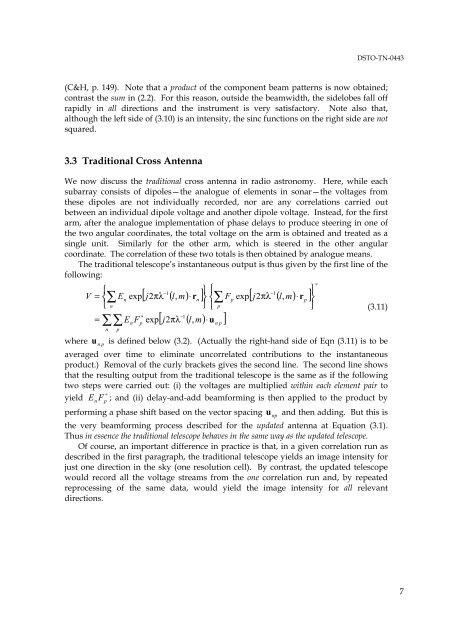Suitability of Correlation Arrays and Superresolution for Minehunting ...
Suitability of Correlation Arrays and Superresolution for Minehunting ...
Suitability of Correlation Arrays and Superresolution for Minehunting ...
You also want an ePaper? Increase the reach of your titles
YUMPU automatically turns print PDFs into web optimized ePapers that Google loves.
DSTO-TN-0443<br />
(C&H, p. 149). Note that a product <strong>of</strong> the component beam patterns is now obtained;<br />
contrast the sum in (2.2). For this reason, outside the beamwidth, the sidelobes fall <strong>of</strong>f<br />
rapidly in all directions <strong>and</strong> the instrument is very satisfactory. Note also that,<br />
although the left side <strong>of</strong> (3.10) is an intensity, the sinc functions on the right side are not<br />
squared.<br />
3.3 Traditional Cross Antenna<br />
We now discuss the traditional cross antenna in radio astronomy. Here, while each<br />
subarray consists <strong>of</strong> dipoles—the analogue <strong>of</strong> elements in sonar—the voltages from<br />
these dipoles are not individually recorded, nor are any correlations carried out<br />
between an individual dipole voltage <strong>and</strong> another dipole voltage. Instead, <strong>for</strong> the first<br />
arm, after the analogue implementation <strong>of</strong> phase delays to produce steering in one <strong>of</strong><br />
the two angular coordinates, the total voltage on the arm is obtained <strong>and</strong> treated as a<br />
single unit. Similarly <strong>for</strong> the other arm, which is steered in the other angular<br />
coordinate. The correlation <strong>of</strong> these two totals is then obtained by analogue means.<br />
The traditional telescope’s instantaneous output is thus given by the first line <strong>of</strong> the<br />
following:<br />
V<br />
⎧<br />
= ⎨<br />
⎩<br />
=<br />
∑<br />
n<br />
n<br />
E<br />
∑∑<br />
p<br />
n<br />
E<br />
exp<br />
n<br />
F<br />
⎧<br />
−1<br />
⎫<br />
−1<br />
[ j2πλ<br />
( l,<br />
m)<br />
⋅ rn<br />
] ⎬ ⎨∑<br />
Fp<br />
exp j2πλ<br />
( l,<br />
m)<br />
⎭ ⎩ p<br />
∗<br />
−1<br />
exp[ j2πλ<br />
( l,<br />
m)<br />
⋅u<br />
]<br />
p<br />
n p<br />
[ ⋅ r ]<br />
p<br />
⎫<br />
⎬<br />
⎭<br />
∗<br />
(3.11)<br />
where u<br />
n p<br />
is defined below (3.2). (Actually the right-h<strong>and</strong> side <strong>of</strong> Eqn (3.11) is to be<br />
averaged over time to eliminate uncorrelated contributions to the instantaneous<br />
product.) Removal <strong>of</strong> the curly brackets gives the second line. The second line shows<br />
that the resulting output from the traditional telescope is the same as if the following<br />
two steps were carried out: (i) the voltages are multiplied within each element pair to<br />
∗<br />
yield E F n p<br />
; <strong>and</strong> (ii) delay-<strong>and</strong>-add beam<strong>for</strong>ming is then applied to the product by<br />
per<strong>for</strong>ming a phase shift based on the vector spacing u<br />
np<br />
<strong>and</strong> then adding. But this is<br />
the very beam<strong>for</strong>ming process described <strong>for</strong> the updated antenna at Equation (3.1).<br />
Thus in essence the traditional telescope behaves in the same way as the updated telescope.<br />
Of course, an important difference in practice is that, in a given correlation run as<br />
described in the first paragraph, the traditional telescope yields an image intensity <strong>for</strong><br />
just one direction in the sky (one resolution cell). By contrast, the updated telescope<br />
would record all the voltage streams from the one correlation run <strong>and</strong>, by repeated<br />
reprocessing <strong>of</strong> the same data, would yield the image intensity <strong>for</strong> all relevant<br />
directions.<br />
7

















